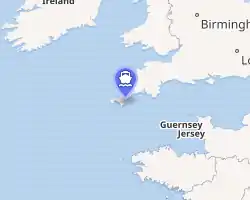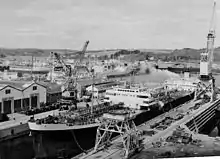Falmouth Docks
Falmouth Docks are a deep-water docks of the town of Falmouth in Cornwall, England, United Kingdom. The docks are the southern shore of the Fal Estuary which is the third largest natural harbour in the world and the deepest in Europe. They extend over 30 ha and covers a range of services to shipping such as repair, refuelling, cleaning and disposal of waste services. The docks are served by the Falmouth Docks railway station. Policing is by the Falmouth Docks Police.
| Falmouth Docks | |
|---|---|
.jpg.webp) Falmouth Docks viewed from Wodehouse Terrace | |

Location in Cornwall | |
| Location | |
| Country | United Kingdom |
| Location | Falmouth, Cornwall |
| Coordinates | 50.1525°N 5.0555°W |
| Details | |
| Owned by | Falmouth Docks & Engineering Co Ltd |
Location
The town of Falmouth is on the south coast of Cornwall in the sheltered natural harbour of the River Fal. Because of the danger of attacks from the sea the earliest towns were inland at Penryn, Tregony and Truro. In the late 17th-century the small town of Falmouth developed with shipbuilding and chandlers and the import of iron, coal, charcoal and timber, and the export of fish to the Mediterranean countries and tin. The Post Office selected Falmouth for its Packet Service in 1688 to Spain and Portugal. A sheltered harbour in the south-west meant ships did not have to sail down channel against westerlies and the Lizard Peninsula gave shelter from those same westerlies. At Its peak In the early 19th-century there were forty vessels sailing to seven ′stations′.[1] A map of Falmouth Haven in the British Museum shows, on the site of Falmouth Docks, Porthan Withe which translates from Cornish as the ″port of shelter or protection″.[2]
Falmouth Docks are built on the northern shore of Pendennis Point, on the estuary of the River Fal which is also known as Carrick Roads. The Fal Estuary is often described as the third largest natural harbour in the world and the deepest in Europe.[2] On the southern side of the docks are Falmouth Docks Railway Station and the terminus of the A39 road.[3]
History

The Falmouth Docks Company was formed after a meeting in Falmouth Town Hall on 31 May 1858 with the aim of keeping the Packet Service, by providing facilities for the new steam-driven ships. James Abernethy, an engineer from Aberdeen was invited to draw up plans on a natural feature known as Bar Point, which extended northwards from Pendennis towards Trefusis Point. The docks was planned covering an area of 150 acres (61 ha). The shallow water was dredged by the Briton and by 1860 a channel of deep water 300 feet (91 m) wide linked the docks with deep water in Carrick Roads. The foundation stone was laid on 28 February 1860 by Lord Falmouth. There is no trace of the stone today. By 1862 No 1 Graving Dock was built along with a warehouse, known as the grain store, which can still be seen.[1]
The Grain Store built between 1860 and 1862 of killas rubble, rock-faced granite dressings and granite-coped parapet with Delabole slate roof. The interior retains the original cross-beam and joust floor structures. The store was listed as grade II on 23 January 1973 with amendments on 24 April 1996.[4]
The Falmouth Dock Company had its own railway from January 1864 which connected it with the Cornwall Railway that had opened from Truro the previous year. The Eastern Breakwater was built in 1863 and No 2 Dock opened in 1864. Its first cargo to be exported was china clay brought on trains along the new railway.[1] The original rail was 7 ft 1⁄4 in (2,140 mm) broad gauge, being converted to 4 ft 8 1⁄2 in (1,435 mm) standard gauge in 1892.[5]
The Directors originally borrowed £50,000 from the Public Works Loan Commissioners at 3.25% and had to borrow a further £20,000 in 1864. In the following year the Western Breakwater collapsed and disappeared from sight, and on 11 May 1866 (on a day known as Black Friday or the Panic of 1866) the Bank of England increased interest rates to 10%. Work on the docks was suspended. The Eastern Breakwater was damaged during a ″hurricane″ in January 1867 and in March of the same year the crew abandoned the brig Uhla which dragged along the same breakwater displacing many piles. By the end of the year the directors handed over possession to the Public Works Loans Commissioners. The breakwater was repaired for £8,500 in 1869.[1] In 1882 the sea bed alongside the Eastern Pier and the Western Wharf was dredged in preparation for an anticipated increase in large steam traffic and a decrease in sail. The following year the 500 feet (150 m) No 2 dry dock was due for completion and a 30-ton crane was proposed for the 400 feet (120 m) Western Wharf.[6]
In the early days the dock was run in a similar fashion to an industrial estate with many different individuals and organisations hiring the facilities. The Docks, Foundry and Engineering Company (renamed Cox and Co in 1871) carried out ship-repairs and the fishing fleet from Lowestoft landed its catch on the beach. Much of Cornwall's grain was imported and distributed from the dock and there was also salvage operations, ship refuelling, coal and timber imports. The British and Irish Steam Packet Company ran a regular service from Dublin to London landing at Falmouth on the Eastern Breakwater.[1]
The Admiralty took over the docks during the First World War and built No 3 Dock, which was larger than the previous two. Due to the German submarine offensive, ship-repair was of enormous strategic importance but the facilities and workforce was unable to deal with the added workload. A London firm of ship-repairers R H Green and Silley Weir sent men to help clear the backlog and their managing director realising the potential of Falmouth bought the dockyard in 1918. Under a new name of Silley Cox and Co, new workshops were built, new machinery installed and skilled workman imported from London. Shipbuilding was a major activity until the 1920s, by which time 198 vessels had been built.[7] A fourth dock was opened in 1928 and new wharves built on the western side of the Western Breakwater. They were Empire (1931–33), King's (1935–37) and Queen's (1938–42).[1] The largest dry dock is the enlarged No 2 Dock, renamed Queen Elizabeth Dock, which was opened, by the Duke of Edinburgh in 1958. This new dock was 850 feet (260 m) in length and able to take the largest ship, then built, at 85,000 tons.[7]
In the 21st century the docks have three graving docks with a capacity of 100,00 dwt and wharfage of 2.5 km. Ship repairs, cleaning and the disposal of waste products are among the facilities offered by the seventeen tenants.[8][9] Pendennis Shipyard relocated to the docks in 1988 and build and repair luxury yachts.[10]
Sport
Falmouth Docks AFC played in the Cornwall Combination League from 1960 to 1985 winning the league in season 1969–70 and losing the league cup final to Porthleven in 1962–63.[11][12]
References
- Gilson, Peter (2002). Britain In Old Photographs. Falmouth. Stroud: Sutton Publishing Limited. pp. 85–96. ISBN 0 7509 3068 3.
- "Falmouth Docks". Falmouth. Retrieved 24 June 2017.
- OS Explorer 103. The Lizard (Map). Southampton: Ordnance Survey. 2015. ISBN 9 780319 243053.
- "Warehouse occupied by Bridon Ropes Limited (The Grain Store)". Historic England. Retrieved 23 June 2017.
- Woodfin, R J (1972). The Cornwall Railway To Its Centenary In 1959. Truro: Bradford Barton. p. 20.
- "Falmouth Docks Company". The Cornishman (217). 7 September 1882. p. 7.
- Acton, Bob (2003). Landfall Walks Books No 3. Around The Fal. Devoran: Landfall Publications. pp. 9–10. ISBN 1 873443 46 3.
- "A&P Falmouth". Falmouth. Retrieved 25 June 2017.
- "Port Operations". A&P. Retrieved 25 June 2017.
- "Heritage". Pendennis. Retrieved 25 June 2017.
- "Falmouth Docks League Record". Cornwall Combination League. Retrieved 22 June 2017.
- "Falmouth Docks Cup Record". Cornwall Combination League. Retrieved 22 June 2017.
Further reading
- David Barnicoat Sailing Ship to Super Liner: Falmouth Docks, 1860-2010; 150 years of service to the shipping industry, Seaman Publications, 2010 ISBN 978-0-9558914-1-0.